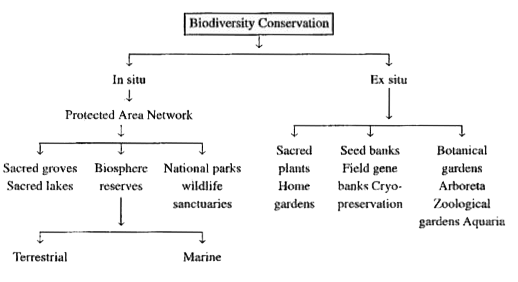How is the biodiversity conserved at all levels?
Text Solution
Conservation. It is the scientific management, preservation and restoration of biodiversity.
Approaches for the conservation of biodiversity. There are two major approaches:
(i) In-situ conservation
(ii) Ex situ conservation.

(1) In situ conservation. It helps to conserve and protect whole ecosystem and biodiversity at all levels.
(1)Hot Spot. On a global basis, conservationists identified for protection certain biodiversity rich regions, called hot spots (i) With very high level of species richness and (ii) High degree of endemism .
(2) Total number of biodiversity hot spots in the world is 34. These hotspot are also the region of accelerated habitat loss.
(3) Three hot spots-western ghats and Srilanka, Indo-Burma and Himalaya cover our country exceptionally high biodiversity regions.
(4) Strict protection of these hotspots reduced the ongoing mass extinction by almost 30%.
(5) In India other biodiversity rich regions are legally protected as national parks, sanctuaries and biosphere reserves.
(6) India has 90 national parks and 448 wildlife sanctuaries and 14 biosphere reserves.
(i) National parks. A national park is an area which is strictly reserved for not allowed. private wild life and where activities such as forestry grazing or cultivation are not allowed. private ownership, rights and habitat, manipulation are not permited in a national park. National parks are set up for preserving flora, fuana landscapes and historic objects of an area. these parks are notified and controlled by central gegislation but are administered by state governments. there are 81 National parks in our country.
(ii) Sanctuarles. A sanctuary is an area which is reserved for the conservation of wild animals only operations such as harvesting of timber, collection of minor forest products and private ownership rights are allowed so long as they do not affect the animals adversely. they are 441 sanctuaries in India.
(iii) Biosphere Reserve. A biosphere reserve is a specified area in which multiple use of land is permitted by dividing it into zones, each for a particular activity.
Zones of biosphere reserve.A biosphere reserve is divided into three zones : core, buffer and munipulation.
(a) The core zone, no human activity is allowed in this zone.
(b) The buffer zone, limited human activity is permitted in this zone.
(c) The manipulation zone, several human activities can occure in this zone.
Role of Biosphere reserve of india. 14 areas habe been declared as Biosphere reserve in India.
(7) In Many cultures,tracts of forest were set aside and all the trees and wildlife within were given religious sancitity and given total protection . such sacred groves are found in khasi and jaintia hills in Meghalaya,aravalli hills of rajasthan, sarguja, chanda and bastar areas of MR.
(8) In meghalaya sacred groves are the last refuges for a large number of rare and threatened, endangered and endemic species.
2. Ex situ conservation.
(i) The threatened animals and plants needing urgent measure to save it from extinction are taken out from the natural habitat and places in special settings where they can be proteccted and given apecial care.
(2) Zoological parks,botanical gardens,wildlife safari parks,serve ex situ conservation.
(3) Now ex situ conservation includes preservation of gametes of threatened species in viable and fertile condition for long period using cryopreservation techniques.
(4) Eggs can be fertilised into vitro and plants can be propogated using tissue culture methods.
(5) Seeds of different genetic strains of commercially important plants can be kept for long periods in seed banks.
|
Topper's Solved these Questions
- BIODIVERSITY AND CONSERVATIONBOOK - BETTER CHOICE PUBLICATIONCHAPTER - BIODIVERSITY AND CONSERVATIONEXERCISE - LONG ANSWER TYPE QUESTIONS (MOST EXPECTED QUESTIONS 5 MARKS)
9 Videos
- BIODIVERSITY AND CONSERVATIONBOOK - BETTER CHOICE PUBLICATIONCHAPTER - BIODIVERSITY AND CONSERVATIONEXERCISE - SHORT ANSWER TYPE QUESTIONS (MOST EXPECTED QUESTIONS 3 MARKS)
16 Videos
- BIOTECHNOLOGY AND ITS APPLICATIONSBOOK - BETTER CHOICE PUBLICATIONCHAPTER - BIOTECHNOLOGY AND ITS APPLICATIONSEXERCISE - LONG ANSWER TYPE QUESTIONS
18 Videos
Similar Questions
Biodiversity Conservation
View SolutionHow the biodiversity can be conserved ?
View Solution(b) How can biodiversity be conserved ?
View SolutionBiodiversity and conservation
View SolutionBiodiversity and conservation
View SolutionBiodiversity and conservation
View SolutionBiodiversity and conservation
View SolutionBiodiversity and conservation
View SolutionBiodiversity is the combined diversity at all levels of biological organisation what are those levels ?
View SolutionBiodiversity is the combined diversity at all levels of biological organisation what are those levels ?
View Solution
